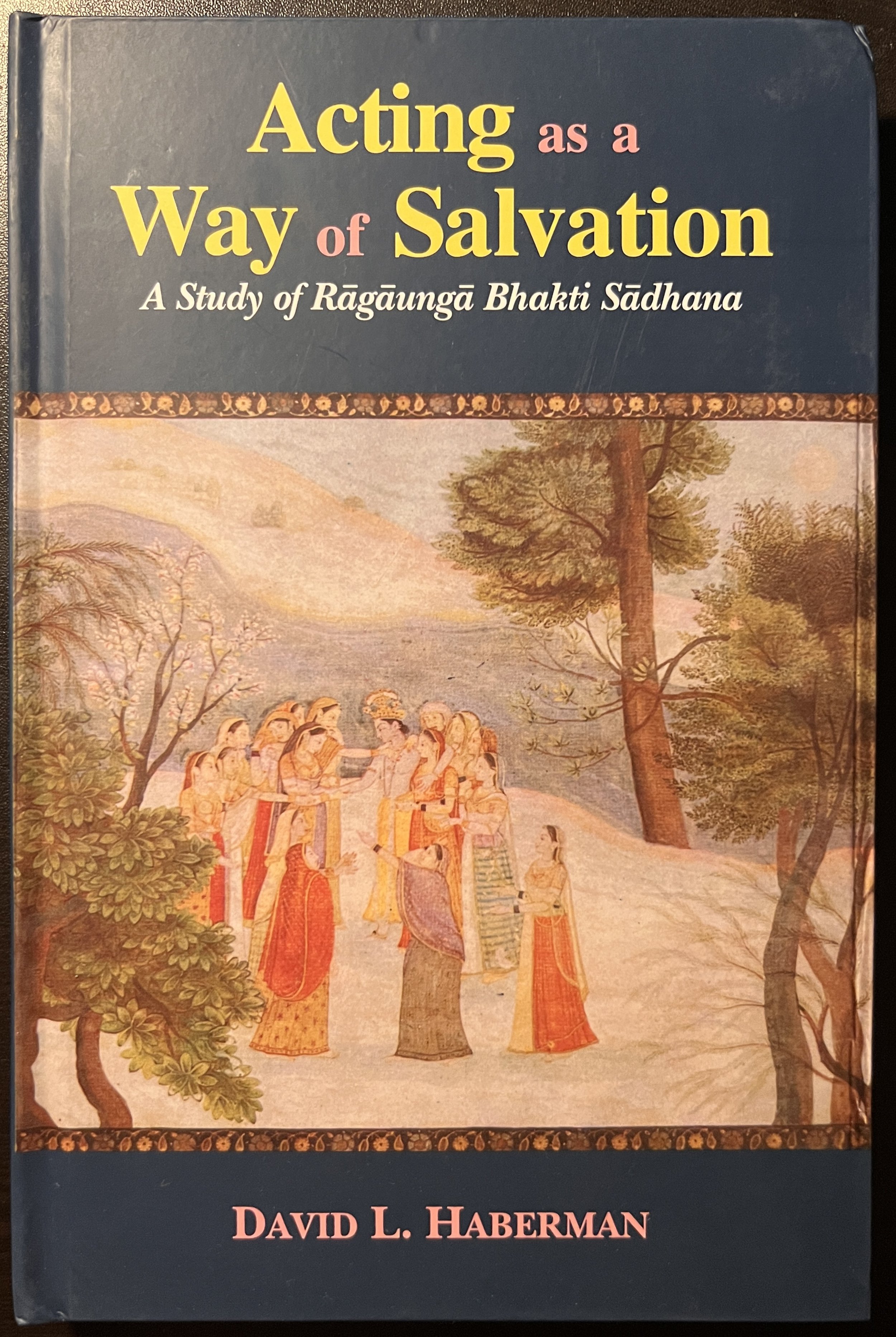Acting as a Way of Salvation : A Study of Raganuga Bhakti Sadhana by David L. Haberman
One of the best written and most thoroughly-researched books on the subject of Raganuga/Vraja Bhakti, with an emphasis on Raganuga Bhakti sadhana.
Excerpts from reviews:
“David Haberman's introduction to this fascinating ritual process guides the reader by deliberate steps worthy of a Vaisnava adept.
For those unfamiliar with the Gaudiya Vaignava tradtion, Acting as a Way of Salvation provides an excellent entree to a little-understand mode of religious realization; for specialists, the basic structure of the system is laid bare, with plenty of textual leads to explore further the details and ramifications of this complex practice.”
-TONY K. STEWART, North Carolina State University
“Haberman's concentration on the notion of a 'paradigmatic individual' is indeed original (even though the 'and there we have it' style of presentation is occasionally overdone); his treatment of the timetabled astayama routine of devotions, and of the ways in which roles for acolytes are determined by their mentors (somewhat belying Edward Dimock's statement in the Foreword that 'Everyone has a role, and it is self-selected') adds greatly to our knowledge of contemporary practice.”
-RUPERT SNELL
“This book concerns certain Hindu worshipers of the god Krishna in North India from around the sixteenth century to the present.
Haberman relates this spiritual discipline to earlier Indian aesthetic theories and practices in which dramatic participation and/or aesthetic appreciation resulted in temporary "de-personalization" or transformation of personality, as well as to the contemporary theories of Constantin Stanislavski concerning an actor's identification with the part he or she is portraying.
Haberman also concludes by discussing certain similarities in the imitative practices of Christian Cistercian monks and Buddhists.”
-DAVID KINSLEY, McMaster University, Hamilton, Ontario LSS 4KI
One of the best written and most thoroughly-researched books on the subject of Raganuga/Vraja Bhakti, with an emphasis on Raganuga Bhakti sadhana.
Excerpts from reviews:
“David Haberman's introduction to this fascinating ritual process guides the reader by deliberate steps worthy of a Vaisnava adept.
For those unfamiliar with the Gaudiya Vaignava tradtion, Acting as a Way of Salvation provides an excellent entree to a little-understand mode of religious realization; for specialists, the basic structure of the system is laid bare, with plenty of textual leads to explore further the details and ramifications of this complex practice.”
-TONY K. STEWART, North Carolina State University
“Haberman's concentration on the notion of a 'paradigmatic individual' is indeed original (even though the 'and there we have it' style of presentation is occasionally overdone); his treatment of the timetabled astayama routine of devotions, and of the ways in which roles for acolytes are determined by their mentors (somewhat belying Edward Dimock's statement in the Foreword that 'Everyone has a role, and it is self-selected') adds greatly to our knowledge of contemporary practice.”
-RUPERT SNELL
“This book concerns certain Hindu worshipers of the god Krishna in North India from around the sixteenth century to the present.
Haberman relates this spiritual discipline to earlier Indian aesthetic theories and practices in which dramatic participation and/or aesthetic appreciation resulted in temporary "de-personalization" or transformation of personality, as well as to the contemporary theories of Constantin Stanislavski concerning an actor's identification with the part he or she is portraying.
Haberman also concludes by discussing certain similarities in the imitative practices of Christian Cistercian monks and Buddhists.”
-DAVID KINSLEY, McMaster University, Hamilton, Ontario LSS 4KI
One of the best written and most thoroughly-researched books on the subject of Raganuga/Vraja Bhakti, with an emphasis on Raganuga Bhakti sadhana.
Excerpts from reviews:
“David Haberman's introduction to this fascinating ritual process guides the reader by deliberate steps worthy of a Vaisnava adept.
For those unfamiliar with the Gaudiya Vaignava tradtion, Acting as a Way of Salvation provides an excellent entree to a little-understand mode of religious realization; for specialists, the basic structure of the system is laid bare, with plenty of textual leads to explore further the details and ramifications of this complex practice.”
-TONY K. STEWART, North Carolina State University
“Haberman's concentration on the notion of a 'paradigmatic individual' is indeed original (even though the 'and there we have it' style of presentation is occasionally overdone); his treatment of the timetabled astayama routine of devotions, and of the ways in which roles for acolytes are determined by their mentors (somewhat belying Edward Dimock's statement in the Foreword that 'Everyone has a role, and it is self-selected') adds greatly to our knowledge of contemporary practice.”
-RUPERT SNELL
“This book concerns certain Hindu worshipers of the god Krishna in North India from around the sixteenth century to the present.
Haberman relates this spiritual discipline to earlier Indian aesthetic theories and practices in which dramatic participation and/or aesthetic appreciation resulted in temporary "de-personalization" or transformation of personality, as well as to the contemporary theories of Constantin Stanislavski concerning an actor's identification with the part he or she is portraying.
Haberman also concludes by discussing certain similarities in the imitative practices of Christian Cistercian monks and Buddhists.”
-DAVID KINSLEY, McMaster University, Hamilton, Ontario LSS 4KI

